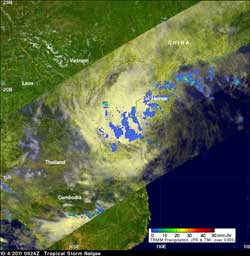NASA Eyes Light Rainfall in Dissipating Tropical Depression Nalgae

This TRMM satellite rainfall image shows only scattered areas of light to moderate rainfall (green and blue, falling at a rate between .78 to 1.57 inches/20 to 40 mm per hour) were present with Nalgae as it moved into the Gulf of Tonkin west of Hainan Island. Credit: NASA Earth Observatory/TRMM/NASA Goddard/Jesse Allen <br>
TRMM measured the rainfall rates in Nalgae on October 4, 2011 at 0624 UTC (2:24 a.m. EDT). The rainfall analysis from TRMM's Microwave Imager (TMI) and Precipitation Radar (PR) showed only scattered areas of light to moderate rainfall were present with Nalgae as it moved into the Gulf of Tonkin west of Hainan Island. Rain was falling at a rate between .78 to 1.57 inches/20 to 40 mm per hour.
By October 5 at 1500 UTC (11 a.m. EDT), Nalgae had weakened into a remnant low pressure area with maximum sustained winds of 20 knots (23 mph/37 kmh) around its circulation center. It was located about 100 nautical miles north of Hue, Vietnam near 18.0 North and 107.3 East. The remnant low was drifting to the west-southwest at 2 knots (2 mph/4 kmh).
The forecasters at the Joint Typhoon Warning Center noted that the movement across Hainan Island weakened the system beyond the point of regeneration. There was no convection (rising air that forms thunderstorms that make up a tropical depression) evident today, Oct. 5. The remnant low is drifting to the coast today.
Text credit: Rob Gutro
NASA/Goddard Space Flight Center, Greenbelt, Md.
Media Contact
All latest news from the category: Earth Sciences
Earth Sciences (also referred to as Geosciences), which deals with basic issues surrounding our planet, plays a vital role in the area of energy and raw materials supply.
Earth Sciences comprises subjects such as geology, geography, geological informatics, paleontology, mineralogy, petrography, crystallography, geophysics, geodesy, glaciology, cartography, photogrammetry, meteorology and seismology, early-warning systems, earthquake research and polar research.
Newest articles

Superradiant atoms could push the boundaries of how precisely time can be measured
Superradiant atoms can help us measure time more precisely than ever. In a new study, researchers from the University of Copenhagen present a new method for measuring the time interval,…

Ion thermoelectric conversion devices for near room temperature
The electrode sheet of the thermoelectric device consists of ionic hydrogel, which is sandwiched between the electrodes to form, and the Prussian blue on the electrode undergoes a redox reaction…

Zap Energy achieves 37-million-degree temperatures in a compact device
New publication reports record electron temperatures for a small-scale, sheared-flow-stabilized Z-pinch fusion device. In the nine decades since humans first produced fusion reactions, only a few fusion technologies have demonstrated…





















